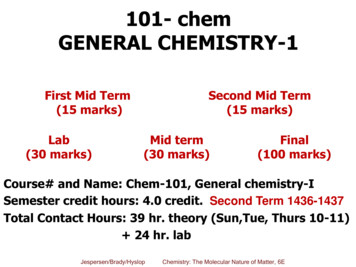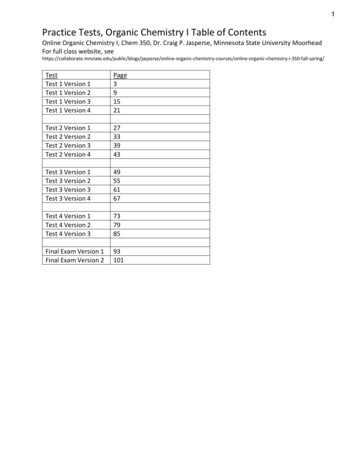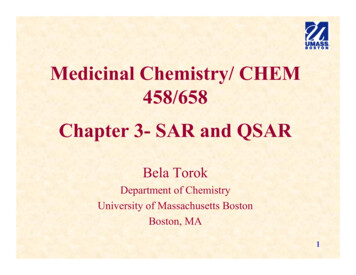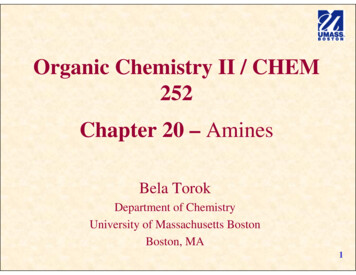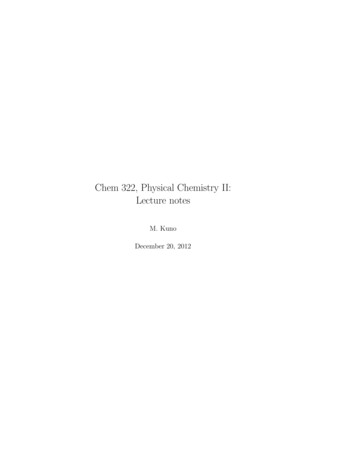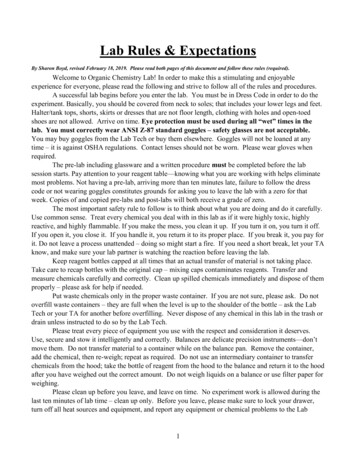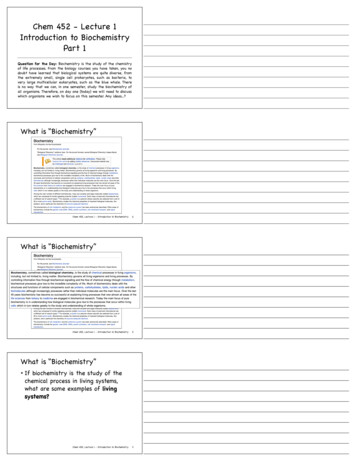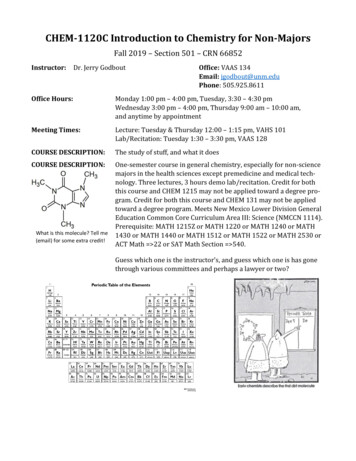
Transcription
CHEM-1120C Introduction to Chemistry for Non-MajorsFall 2019 – Section 501 – CRN 66852Instructor:Dr. Jerry GodboutOffice: VAAS 134Email: jgodbout@unm.eduPhone: 505.925.8611Office Hours:Monday 1:00 pm – 4:00 pm, Tuesday, 3:30 – 4:30 pmWednesday 3:00 pm – 4:00 pm, Thursday 9:00 am – 10:00 am,and anytime by appointmentMeeting Times:Lecture: Tuesday & Thursday 12:00 – 1:15 pm, VAHS 101Lab/Recitation: Tuesday 1:30 – 3:30 pm, VAAS 128COURSE DESCRIPTION:The study of stuff, and what it doesCOURSE DESCRIPTION:One-semester course in general chemistry, especially for non-sciencemajors in the health sciences except premedicine and medical technology. Three lectures, 3 hours demo lab/recitation. Credit for boththis course and CHEM 1215 may not be applied toward a degree program. Credit for both this course and CHEM 131 may not be appliedtoward a degree program. Meets New Mexico Lower Division GeneralEducation Common Core Curriculum Area III: Science (NMCCN 1114).Prerequisite: MATH 1215Z or MATH 1220 or MATH 1240 or MATH1430 or MATH 1440 or MATH 1512 or MATH 1522 or MATH 2530 orACT Math 22 or SAT Math Section 540.What is this molecule? Tell me(email) for some extra credit!Guess which one is the instructor’s, and guess which one is has gonethrough various committees and perhaps a lawyer or two?
WHAT YOU’LL LEARNCOURSE TEACHING & LEARNING OUTCOMESRelevant sections are given in [brackets] after each SLOBy the end of this course, a successful student will be able to:1. Use dimensional analysis, the SI system ofunits and appropriate significant figures toexpress quantities, convert units and perform quantitative calculations in science.[Appendix B, 1.4 – 1.6]2. Diagram the structure of the atom in termsof its subatomic particles; and justify the existence and nature of the subatomic particles and the scale of the nucleus using appropriate experiments from scientific history. [2.2 – 2.3]3. Use the IUPAC system of nomenclature andknowledge of reaction types to describechemical changes, predict products andrepresent the process as a balanced equation. [3.7, 4.3]4. Apply the mole concept to amounts on amacroscopic and microscopic level and usethis to perform stoichiometric calculationsincluding for reactions in solution andgases. [2.4, 6.1 – 6.4, 7.3, 8.3]5. Apply the gas laws and kinetic moleculartheory to relate atomic level behavior tomacroscopic properties. [8.1 – 8.5]6. Describe the ways in which atoms combineto form molecules (ionic and covalent). Apply knowledge of electronic structure to determine molecular structure, geometry andhybridization. [4.1 – 4.6, 5.1 – 5.3]7. Analyze how periodic properties (valence,electronegativity, etc.) and reactivity of elements result from electron configurationsof atoms. [3.5 – 3.7]8. Explain the intermolecular attractive forcesthat determine physical properties; applythis knowledge to qualitatively evaluatethese forces; and predict the physical properties that result. [10.1 – 10.2]9. Calculate solution concentrations in variousunits and explain the effects of temperature,10.11.12.13.14.15.16.17.pressure and structure on solubility. [11.1 –11.4]Explain rates and rate laws; determine therate, rate law and rate constant of a reaction; and calculate concentration as a function of time and vice versa. [17.1 – 17.5]Explain the collision model of reaction dynamics, including activation energy, catalysts and temperature; derive a rate lawfrom a reaction mechanism; and evaluatethe consistency of a mechanism with agiven rate law. [17.6]Recognize oxidation-reduction reactions;and identify oxidizing and reducing agents.[16.1 – 16.2]Describe the dynamic nature of chemicalequilibrium and its relation to reactionrates; and apply Le Chatelier’s Principle topredict the effect of concentration, pressureand temperature changes on equilibriummixtures. [13.1 – 13.3]Describe the equilibrium constant and useit to determine whether equilibrium hasbeen established; and calculate equilibriumconstants from equilibrium concentrationsand vice versa. [13.4]Describe the different models of acids andbase behavior and recognize common acidsand bases. [14.1 – 14.4]Apply equilibrium principles to aqueous solutions, including acid-base and solubilityreactions; calculate pH and species concentrations in buffered and unbuffered solutions. [14.5 – 14.7]Recognize the basic radioactive decaymodes, compare the penetrating and ionizing power of various types of radiation, fillin a missing species in a balanced nuclearequation and perform half-life calculationsfor radioactive isotopes. Time permitting[20.1 – 20.3]If none of these make any sense to you at the beginning of the semester – Fret Not!We’re literally here so you can learn this stuff!
COURSE/INSTRUCTOR COMMUNICATIONS Email is the most effective. Electronic communication for this course MUST be through your UNMemail or UNM Learn Messaging.When requesting an appointment (which I am always happy to schedule), please propose three (3)times that work for you in your initial request. This will simplify and quicken the processIt is the responsibility of the student to keep up with course announcements. Check your UNMemail and Blackboard Learn daily!WHAT YOU’LL NEED(COURSE MATERIALS) Text Atoms First from OpenStax, Print ISBN 1-947172-64-6, Digital ISBN hemistry-atoms-first-2e Go to the following web address or scan the QR code on the left. This textbook isavailable for free online! If you prefer, you can also get a print version ata very low cost. The text is available in web view and PDF for free. Youcan also choose to purchase on iBooks or get a print version via fromOpenStax on Amazon.com. You can use whichever formats you want.Course TextWeb view is recommended -- the responsive design works seamlessly onany device. If you buy on Amazon, make sure you use the link on your book page on openstax.org so you get the official OpenStax print version.Access to UNM Valencia networks, UNM Learn and UNM email: Network access isnecessary for some lab activities. Course materials will be posted on UNM Learn and importantclass announcements will be made to your UNM email address. Please check your email regularly. Valencia campus provides internet and computer access at the library, Learning ResourceCenter, and STEM center.Safety glasses/goggles for lab: please purchase those in the bookstore to avoid any question of their safety ratingA NON-PROGRAMMABLE scientific calculator with log/antilog and exponential functions: TI30Xa TI-30X IIS TI-30XS Casio or Sharp equivalents (cell phones and graphing calculatorsare not acceptable). Visit r/ will help you tell the difference, or ask your instructor.A notebook (or space in a binder) too write down, space out the problems/questions, and to show your work before you submit answers electronically; (3) have it readily available when working with fellow classmate(s), tutor(s) and/or instructor; (4) use as review/study material.
HOW DO I EARN ALL THOSE POINTS?HOW MANY POINTS DO I NEEDFOR AN A?(Exams, Quizzes, Homework, and the Like)Final TotalHowMany1(What’s the grading scale?)Points 42521500*Earn ThisMany 08250*Ifyou do the math, you will notice that this adds up to 1538points. The scale however, is based in 1500 points, so there38 points of extra credit. In addition, the 130-point in-classexams will actually have 140 points. This means that thereare actually a total of 58 points of extra credit possible.EXAMSThink of these as opportunities for you to showjust how much you have learned. The exam format consists of three types of questions: multiple-choice, short-answer, and multiple part. Tohelp you figure out how well you understand thematerial, approximately a week in before eachexam, a Practice Exam with the Answer Key willbe published for students’ useThere are 4 scheduled in-class exams tentativelyon the dates below, although the instructor reserves the right to alter course schedule as the semester progresses. Students will be given advance notice of any change.Exam 1Exam 2Exam 3Exam 4FinalChapters1–34, 6 – 79 – 1113 – 161 – 4, 6 – 11,13 – 17Date*1 Feb22 Feb12 Apr3 May10 May(12:00 – 2:00p.m.)Get ThisGradeA AAB BBC CCD DDF FWHAT WILL EACH CLASS BE LIKE? Quiz: covering material recently covered and any assigned preparation(reading, video, etc)Course BusinessGroup Activity: collaborative exercise to help you master that day’stopicReflection: an opportunity to put theday’s lesson into larger perspective,and formulate/ask questionsWHAT WILL MY ROUTINE BE LIKE? **The final exam must be taken to pass the course,regardless of points accumulated to that point Before Class: complete any prepatoryassignment (reading, video, etc)During Class: work with your groupto master concepts. The more you putin, the more you’ll get outAfter Class: work on homework assignment relevant to that day’s topic(review notes, WORK ON PROBLEMS, think of questions for officehour visits, etc.Repeat 29 times!:
WHEN WE LEARN THIS STUFF?(Schedule is approximate and subject to change by the 324252627282930DateTue 20 AugThu 22 AugTue 27 AugThu 29 AugTue 03 SepThu 05 SepTue 10 SepThu 12 SepTue 17 SepThu 19 SepTue 24 SepThu 26 SepTue 01 OctThu 03 OctTue 08 OctTue 15 OctThu 17 OctTue 22 OctThu 24 OctTue 29 OctThu 31 OctTue 05 NovThu 07 NovTue 12 NovThu 14 NovTue 19 NovThu 21 NovTue 26 NovTue 03 DecThu 05 DecTue 10 DecLecture TopicsMath you’ll need to know(1.4 – 1.6, Appendix B)Atoms, Molecules, and Ions (2.1 – 2.4)Electronic Structure and Periodic Properties of Elements (3.1 – 3.7)Exam 1 (Chapters 1 – 3)Chemical Bonding and Molecular Geometry (4.1 – 4.6)Composition of Substances and Solutions (6.1 – 6.4)Stoichiometry of Chemical Reactions (7.1 – 7.4)Exam 2 (Chapters 4, 6, 7)Gases (8.1 – 8.5)Thermochemistry (9.1 – 9.4)Liquids and Solids (10.1 – 10.6)Solutions and Colloids (11.1 – 11.4)Exam 3 (Chapters 9 – 11)Kinetics (17.1 – 17.7)Fundamental Equilibrium Concepts (13.1 – 13.4)Acid-Base Equilibria (14.1 – 14.7)Equilibria of Other Reactions Classes (15.1 – 15.2)Exam 4 (Chapters 13 – 16)Electrochemistry (16.1 – 16.3)Final Exam (12:00 – 2:00 pm)
Other Things That Aren’t Chemistry, But Are Still Important(Class Policies and Important Dates) Be There Attendance in lecture andlab/recitation is mandatory. Studentsare expected to attend all meetings ofthe classes in which they are enrolled.o A student with excessive absencesmay be dropped from a course bythe instructor with a grade of WP orWF or the student may receive agrade of F at the end of the semester.o I will exercise my discretion withoutnotice to drop any student who: misses the first two lecturesand first lab/recitation; has not completed any assignments in Connect by theend of the 2nd week; after 2 consecutive unexcused absences; after 4 total absences.o An excused absence must be communicated.o Students are limited to 2 excusedabsences BUT they may not beused for days of Exams Be on time. Lectures and labs/recitations will begin promptly. After 10minutes, a student will be counted absent. Late arrival or early departure isunacceptable. Absences due to illness orany mitigating circumstance are unavoidable but must be documented orapproved in advance. If you must miss alecture or lab, email me ASAP in orderto get your absence excused and discusswhen you will turn in or make up anyallowable assignments. Students are responsible for all assignments regardlessof attendance.Your job begins when class ends:Electronic homework will be assignedregularly and will be available for aweek and over a weekend. Your answers (worked out in your HomeworkNotebook) are to be submitted andscored on Connect. Late homework willnot be accepted.Important Dates & HolidaysFri, 30 Aug 2019Mon, 02 Sep 2019Fri, 06 Sep 2019Thu, 10 Oct 2019Fri, 08 Nov 2019Thu, 28 Nov 2019Fri, 07 Dec 2019Wed 12 Dec 2018Last day to register, ADD sections, and change credit hours on LoboWebEnrollment cancellation for non-paymentUniversity Holiday – Labor DayLast Day to DROP without “W” grade and 100% tuition refund on LoboWEB,Last Day to CHANGE grade optionUniversity Holiday – Fall BreakLast Day to withdraw WITHOUT Dean’s PermissionUniversity Holiday – ThanksgivingLast day to change grading optionsLast Day to withdraw WITH Dean’s PermissionFinal Exam (for this section)
Other Things That Aren’t Chemistry, But Are Still Important(University Policies)Equal Access ServicesIf you have a documented disability or psychological/medical condition that may affectyour performance in this class, please register with Equal Access Services as soon aspossible so I can provide your accommodations in a timely manner. EAS can provide aquiet place to take exams, additional time,and additional services if there is a documented need. For more information, pleasesee their website athttp://www.unm.edu/ vcadvise/equalaccess.htm, or scan the following QR code:Equal Access ServicesAcademic HonestyEach student is expected to maintain thehighest standards of honesty and integrity inacademic and professional matters. The University reserves the right to take disciplinaryaction, including dismissal, against any student who is found responsible for academicdishonesty. Any student who has been judgedto have engaged in academic dishonesty incoursework may receive a reduced or failinggrade for the work in question and/or for thecourse. Academic dishonesty includes, but isnot limited to, dishonesty in quizzes, tests orassignments; claiming credit for work notdone or done by others; hindering the academic wok of other students; and misrepresenting academic or professional qualifications within or outside the University. Depending on the severity of the offense, students caught cheating may receive a zero onthe assignment, be dropped from the course,or receive an ‘F’ in the course. Don’t cheat.Sexual Misconduct and Gender DiscriminationIn an effort to meet obligations under Title IX,UNM faculty, teaching assistants, and graduate assistants are considered responsible employees. This designation requires that anyreport made to a faculty member, TA, or GAregarding sexual misconduct or gender discrimination must be reported to the Office ofEqual Opportunity and the Title IX Coordinator. For more information on this 2000/2740.html or scan the followingQR Code:Title IX Policy
COURSE DESCRIPTION: The study of stuff, and what it does COURSE DESCRIPTION: One-semester course in general chemistry, especially for non-science majors in the health sciences except premedicine and medical tech-nology. Three lectures, 3 hours demo lab/recitation. Credit for both this course
